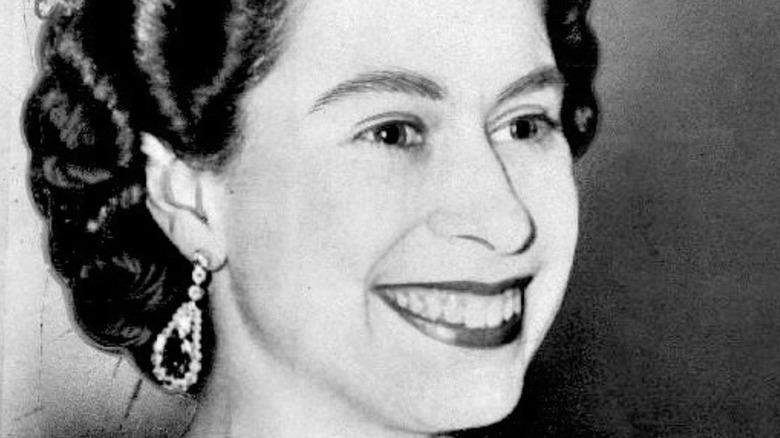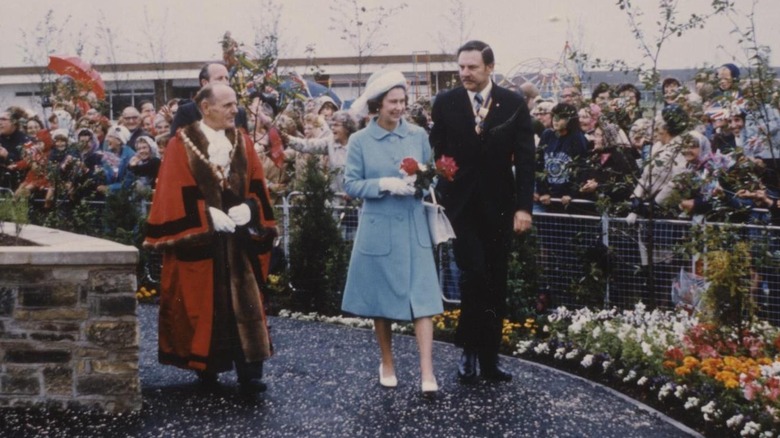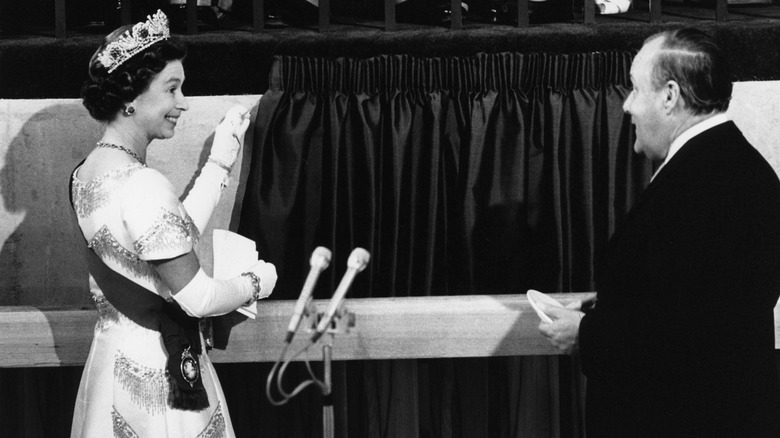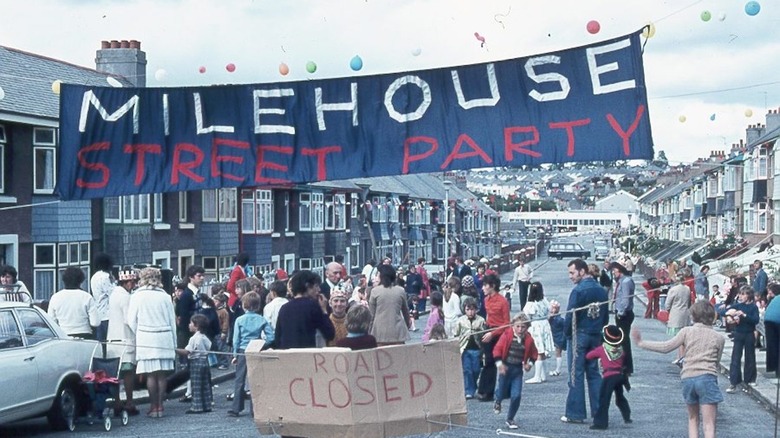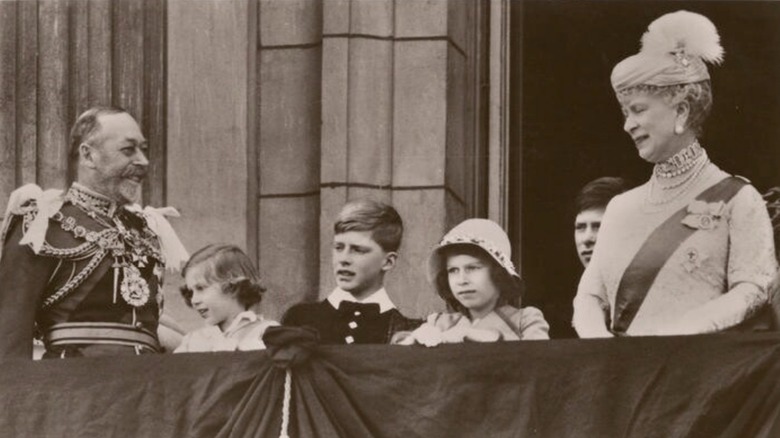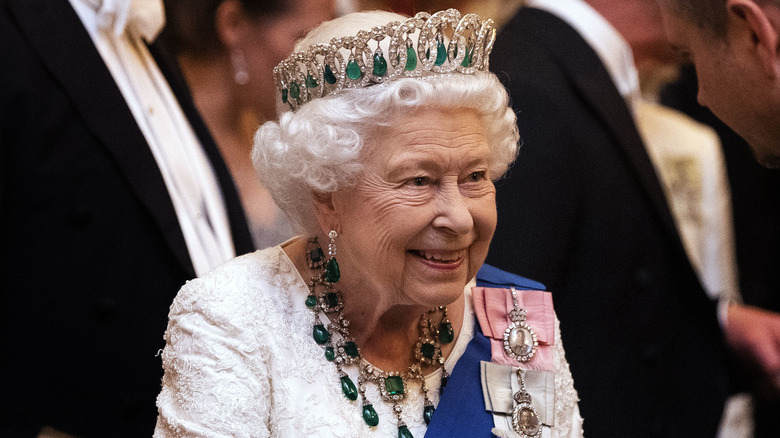What Really Happened At Queen Elizabeth II's First Ever Royal Jubilee?
Royal jubilees have been relatively rare in the past, but less so during Queen Elizabeth II's reign. This year will mark her fourth.
Though this year's celebration, the Platinum Jubilee, will commemorate the queen's 70 years on the throne, it will coincide with the 69th anniversary of her coronation, which took place June 2, 1953, more than a year after her father died and she became queen (via The Royal Family).
A jubilee celebrates a milestone year in a monarch's reign. In the U.K., it also serves to "reinforce the Sovereign's role as a focus for national identity and unity," according to the Royal Family's website.This is the queen's third in 20 years: in 2002 she celebrated her Golden Jubilee, marking 50 years on the throne, and in 2012 was her Diamond Jubilee, marking 60 years on the throne. Her very first was back in 1977, when her Silver Jubilee commemorated her first 25 years as queen. What happened that year?
Queen Elizabeth's UK tour
The queen's Silver Jubilee kicked off on February 6, 1977, the anniversary of the day she became queen. The rest of the month saw many church services celebrating this anniversary, but further celebrations happened later in the year.
On May 17 in Glasgow, Scotland, the queen began a three-month tour of the U.K. Huge crowds turned out to see her: around 1 million people came out in the county of Lancashire in one day. The queen covered 36 counties on her tour. According to the royal family, no other monarch had seen so much of the country in such a short time. The tour ended with a garden party at Hillsborough Castle in Northern Ireland (via Historic Royal Palaces).
That year, the Queen's Silver Jubilee Appeal began. People could donate money to celebrate the jubilee, and the queen earmarked it for services supporting young people, and specifically, encouraging them to do community service. This program still exists, as The Queen's Trust (via The Royal Family).
Queen Elizabeth's Commonwealth tour
After her U.K. tour, Queen Elizabeth II visited member nations of the Commonwealth, which is made up of former British dependent states that have maintained ties with the U.K. (via Britannica). On this tour, the queen visited Australia, New Zealand, Canada, and Fiji, among other countries (per The Royal Family). In New Zealand, the queen followed the same itinerary she had during her 1953-54 visit. She also opened the Beehive, a new wing of the New Zealand Parliament building, according to New Zealand History.
In Canada, she went to an opening session of Parliament and delivered a speech, the second time she had done so there, according to the Government of Canada. She did the same in the Bahamas and New Zealand. In Scotland and Australia, she inspected military troops (via Elle).
She chose an Australian painter, Paul Fitzgerald, to paint a portrait of her commemorating the jubilee. He had previously painted Pope John, Prince Philip, and Prince Charles. He described the queen to The Australian Women's Weekly as a "warm and inspiring subject."
Early June celebrations
The main celebration of the Silver Jubilee in England occurred from June 6-9, 1977. It began with the queen lighting a beacon bonfire at Windsor Castle. Others were lit around the country. The next day, the queen went to St. Paul's Cathedral in the Gold State Coach for a service of thanksgiving. Afterwards, according to their website, the royal family went to a lunch at the London Guildhall. The queen made a speech, telling the mayor of London, "When I was 21, I pledged my life to the service of our people, and I asked for God's help to make good that vow. Although that vow was made in my salad days, when I was green in judgment, I do not regret nor retract one word of it."
The rest of the day was busier for the common people than for the queen: all around the country, towns and neighborhoods held parties in her honor. There were around 4,000 parties in London alone. The queen herself returned to Buckingham Palace in a procession watched on TV by an estimated 500 million people. She then made several appearances on the palace balcony.
On June 9, the queen took a trip down the River Thames from Greenwich to Lambeth, London, similar to Elizabeth I's barge trips down the river. The day included more fireworks, another procession, and more balcony appearances (via The Royal Family).
The history of royal jubilees
British royals have been celebrating their jubilees since at least 1376, when King Edward III commemorated 50 years on the throne with a weeklong jousting tournament in London. Trumpets announced his progress from the Tower of London to the jousting field, according to Historic Royal Palaces.
Like Elizabeth II, many monarchs have attended services of thanksgiving at St. Paul's Cathedral in London as part of their jubilees. These include King George III, King George V, and Queen Victoria for her Diamond Jubilee. Several monarchs have also appeared publicly on the balcony of Buckingham Palace, so crowds could see them, during their jubilees. Elizabeth was pictured there at only 11 during the Silver Jubilee of her grandfather, George V. George V is the first British monarch known to have celebrated a Silver Jubilee.
Queen Victoria was the first royal to have a Diamond Jubilee, and the only one in addition to Elizabeth II. Victoria's jubilee celebrations were among her few public appearances after the death of her husband, Prince Albert (via Historic Royal Palaces).
Plans for the queen's platinum jubilee
Though the queen's Platinum Jubilee will be celebrated all year, the main events will be during the weekend of June 2-5, which has been declared a holiday. The weekend will kick off with a military parade, which will be broadcast live and shown on big screens in St. James's Park, London, for those who can't see it in person. The royal family will appear on Buckingham Palace's balcony afterwards, and a flyover will mark the occasion. As during her past jubilees, people will be lighting beacons all over the country — more than 1,500 total — as a national "symbol of unity," according to the royal family's website.
The rest of the weekend will include the traditional thanksgiving service at St. Paul's, a horse race called the Derby at Epsom Downs, and the Platinum Party at the Palace, which will have 22,000 attendees. On the last day of the celebrations, people all over the country will be hosting "Big Jubilee Luncheons" in their neighborhoods. The last big event will be a pageant, which will "will bring to life iconic moments from The Queen's reign," according to the royal family's website.The pageant will involve celebrities, the military, and a gospel choir among others. Though lacking the grand tour, this jubilee's U.K. events should be just as festive as in 1977.
